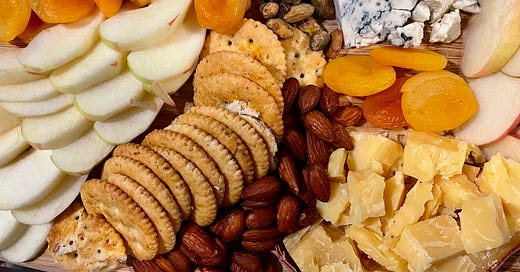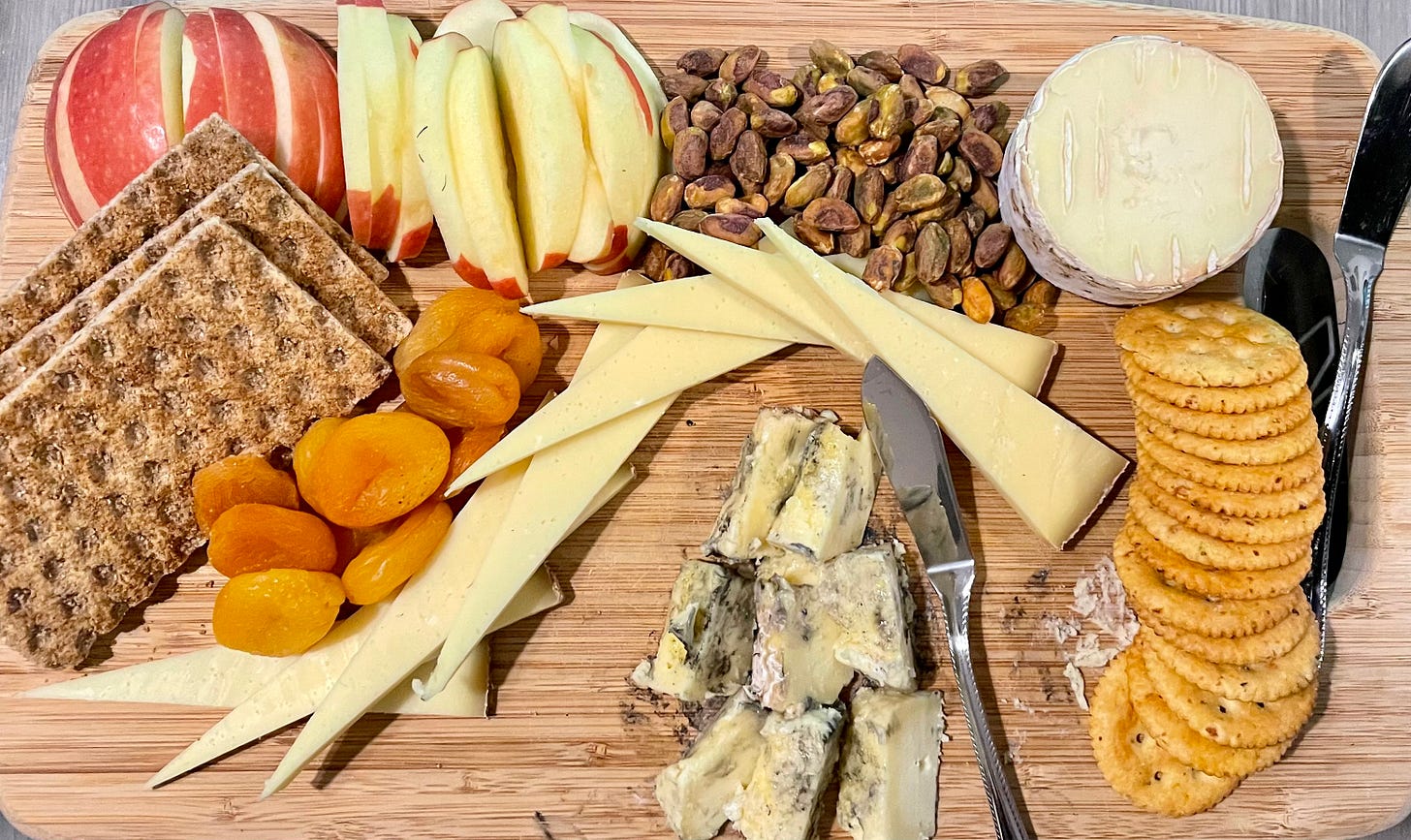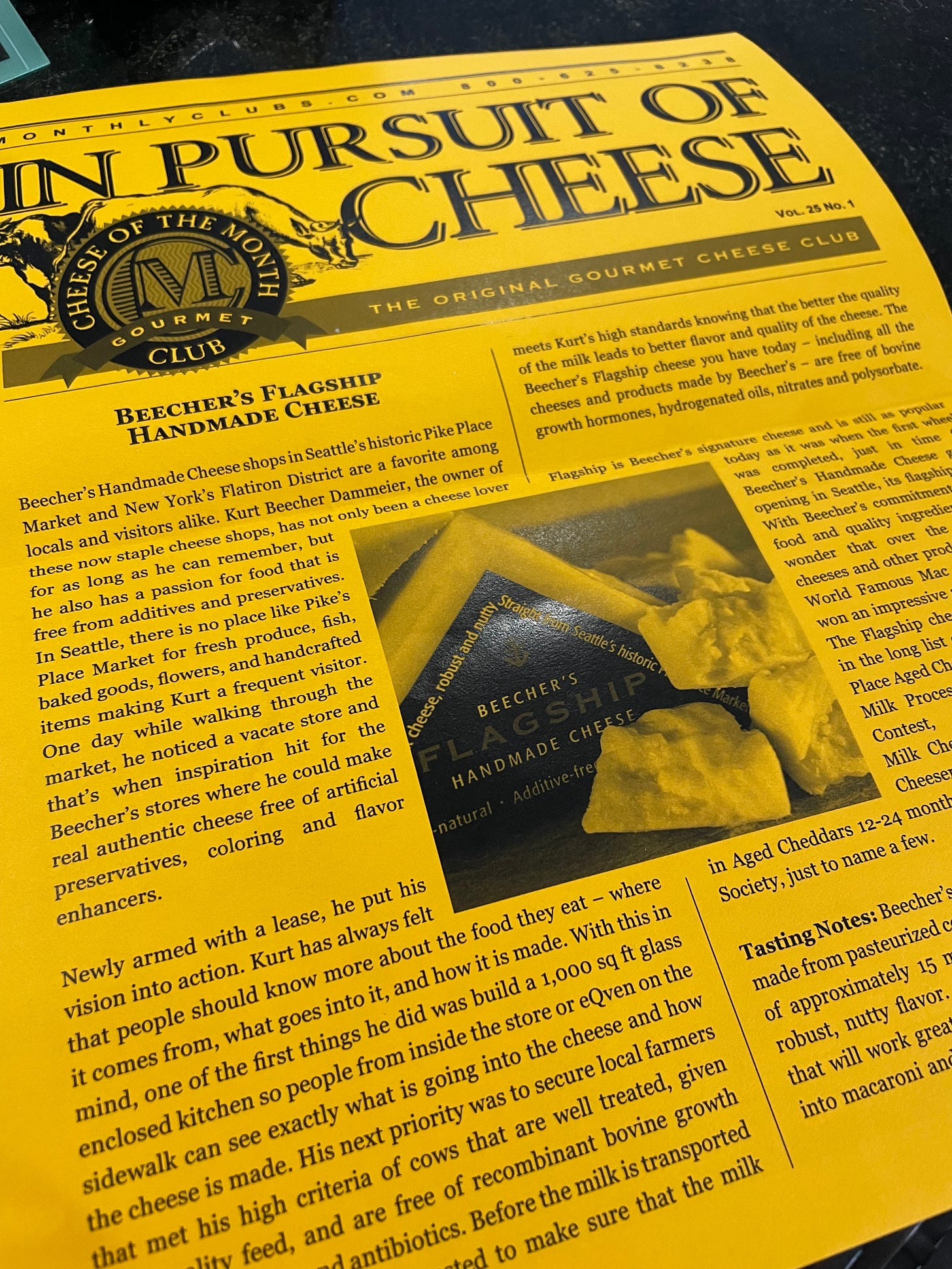What Does it Mean to Join the Curd Herd?
An honest review of two monthly cheese clubs by a former cheesemonger
What do you give the totally cheese obsessed for Christmas (or any occasion really)? Every article on the subject will recommend sending your cheesy friend one of the many available cheese clubs. These cheese clubs, or cheese subscriptions, can be from a specific shop, cheesemaker, or gourmet food service and last for a chosen amount of time (usually 1, 3, 6, or 12 months). Once a month, an assortment of cheeses and/or accoutrements comes to your door, no decision making required! In addition to being a convenient way to purchase cheese from a specific source, each box is an opportunity to try new cheeses that may not be available in your local shop or that you would typically choose. Personally, I see these clubs as immersive, interactive cheese education.
As a former cheesemonger who always dreams of cheese, both my parents and my partner’s parents gifted us subscriptions to monthly cheese clubs. The first is more popular: Murray’s Explorer Cheese Club, while the second is less well-known: the Gourmet Cheese of the Month Club from MonthlyClubs.Com. My general excitement soon switched to a researcher’s curiosity. Which cheese club is better than the other? How do these two different cheese clubs help educate consumers about cheese? Each month I will give my honest review of both clubs taking into consideration cheese selection and quality, professionalism of presentation, and educational content and accessibility.
*I have not been paid to write these reviews. This, and posts related to this one, reflect my personal opinion and experience in hopes that it helps other people thinking of using or starting similar services. The aim is to reflect on the educational opportunity and effectiveness these subscription services/clubs may or may not provide.
Month 1: (Dry) January
Murray’s Cheese
The cheeses:
Hornbacher (Switzerland, Raw Cow)
Quinta from Point Reyes (California/USA, Cow)
Sappy Ewe from Nettle Meadow (New York/USA, Sheep/Cow)
Bonus: Murray’s Camembert
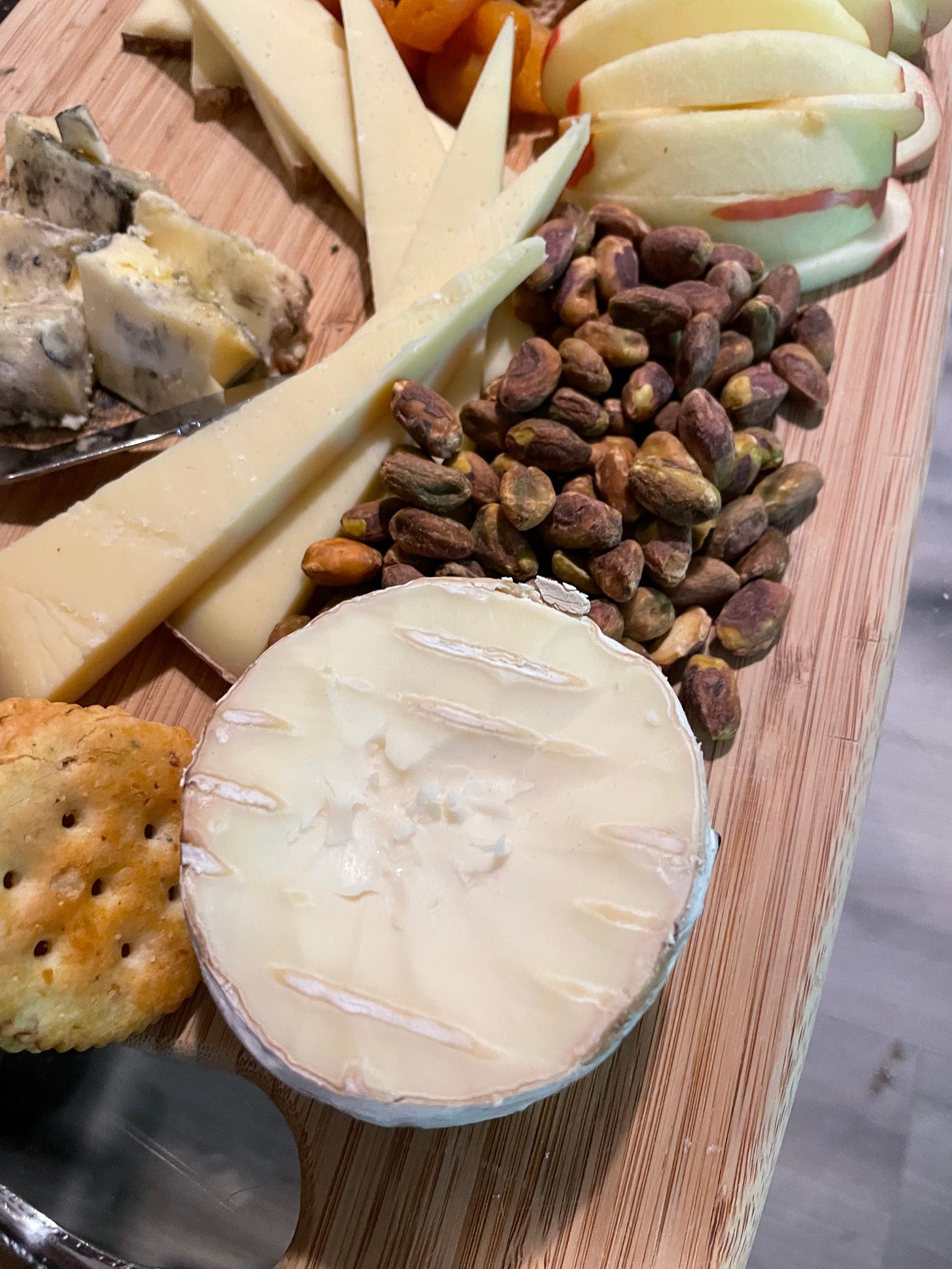
Murray’s Cheese started as a specialty food and cheese shop in New York City’s Greenwich Village in 1962. They now have three locations and two restaurants in New York City as well as numerous satellite locations in Kroger’s delis across the country. They offer several different cheese club options as well as a mac and cheese club!
Right away Murray’s made me and my partner feel excited about being in the club. The packaging was super cute, with a custom-printed box featuring Murray’s Cheese designs. Our first box included a “member” card, pin-back button, refrigerator magnet, sticker sheet, and a postcard. (My partner and I will be fighting over the stickers.) The informational card came as a PDF in our email inbox and as a hard copy in the box. All the cheese came wrapped in cheese paper or specially-made wrapping.
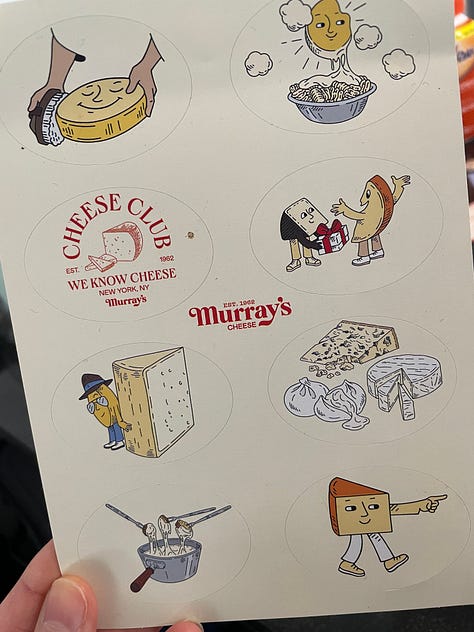

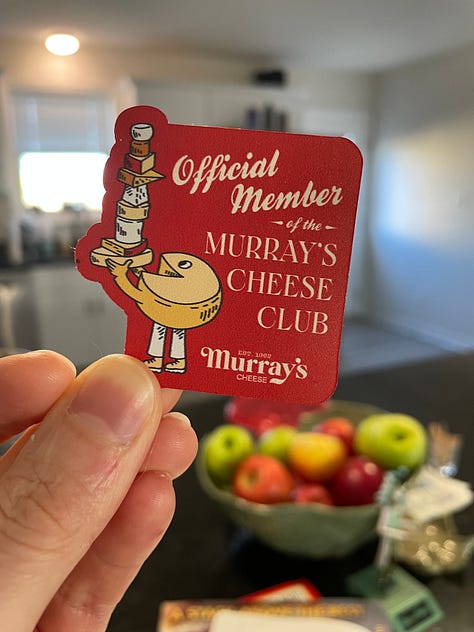
The informational pamphlet included a short background about each cheese with pairing suggestions, a “monger lesson,” storage and pairing advice, and a QR code to take you to Murray’s guide for cutting and serving cheese. The cheese lesson for January was on sheep’s milk cheeses. I enjoyed the separate cheese lesson as well as the balance they struck between brevity and depth. However, I would have liked the cheese selection to mirror the featured cheese lesson more. Only one of the cheeses included sheep’s milk, Sappy Ewe, a bloomy-rind, mixed-milk cheese from New York. With so many delicious sheep’s milk cheeses out there, it felt like a missed opportunity to emphasize the uniqueness of sheep’s milk and how it transforms during the cheese making process.


The cheeses were a variety of styles: an aged Swiss cooked curd Cow’s milk cheese; a bark-wrapped California-original; and an upstate New York ash-rinded, wrinkly pyramid. I thought it was brave of Murray’s to ship so many soft and semi-soft cheeses as they are more physically fragile and perishable. And it is here where the sadness begins…. The “bonus” cheese, Murray’s Camembert, to my cheesemonger eye was past its prime. The cheese gave under my touch easily and was obviously very ripe. Its funky aroma generated complaints from roommates, and upon investigation revealed a cheese gasping for its last breath. My partner threw her out before I could pay my last respects. Rest in Cheesus. Then, the cheese I looked forward to the most, Sappy Ewe— a sheep/cow milk truncated pyramid from Nettle Meadow Artisan Cheese with curds washed in maple syrup and an ashed, bloomy geotricium rind —revealed its sad fate. As I unwrapped the cheese, the rind slipped off and the separated butterfat oozed out. The cheese smelled of dirty barn and very sheepy. I tried to salvage the cheese, but the rancid flavor of the center paste made continued resuscitation useless. Rest in Cheesus.
It is not all sad though! Hornbacher, a raw cow’s milk cheese from Switzerland, is a newcomer to the long tradition of Swiss cheeses. Named after the river where it is made, Hornbacher affectionally goes by the nickname “baked potato cheese” for its rind that looks like a baked potato’s skin and its brothy, bacony, green onion flavor. I have enjoyed this cheese several times, and it is always delightful. This wedge was no exception! Quinta from Point Reyes Farmstead Cheese had been on my radar because everything I have tasted from Point Reyes— a family dairy farm and cheesemaking business currently run by sisters —has been excellent. The bay laurel bark-wrapped button had a single bay leaf decorating the top and a whitish-gray mold mottling the outside. The cheese is spoonable, unctuous, and herbaceous from the bay infusing in from the bark belt. Would eat this California original again!
Pros: Selection was unique and genuinely felt exploratory. Presentation was fun and generated enthusiasm for eating and learning about cheese! Information was brief but thorough— a great launchpad for learning more.
Cons: The quality of cheese upon arrival was…heartbreaking, but this issue could have numerous causes, from the level of risk in the selection of more perishable cheeses, carelessness of packers, or temperature change during transit. The presented monger lesson did not focus on the selected cheese.
MonthlyClubs.Com
The cheeses:
Beecher’s Flagship Homemade Cheese (Washington/USA, Cow)
Salemville Amish Blue (Wisconsin/USA, Cow)
Artikaas Vintage Lot 36 (The Netherlands, Cow)
I did not know what to expect from the Gourmet Cheese of the Month Club from MonthlyClubs.com. My mum chose it because it was cheaper than Murray’s clubs and guaranteed half a pound each of three cheeses. Started in 1994, MonthlyClubs coordinates with Zingerman’s Deli in Ann Arbor, Michigan to help select and ship the cheeses. Zingerman’s started as a Jewish deli in 1982 and has since expanded into several specialty food subsidiary businesses, including a cheese counter and creamery.
My first impression was that someone did their research. All the cheese came wrapped in Formaticum cheese bags sealed with a sticker bearing the cheese’s name. Formaticum cheese bags are a great choice for using at home as consumers do not have to try to achieve the same neat, origami-like folds of a practiced cheesemonger. The use of cheese bags rather than wrapping the cheeses in cheese paper indicated to me either a lack of skill or time. The rest of the box mainly contained promotional materials for the many other food and drink clubs.
They refer to the accompanying information sheet as that month’s cheese newsletter. It looked like a community newsletter too. Printed on yellow paper, with columns of type in a tiny font and black and white images, each cheese’s maker, tasting notes, and suggested pairings had a thorough description. These descriptions felt very copy/paste and disjointed, and the length along with the tiny font would probably deter many consumers from reading all the way through. They provided no information on storage or serving either, though luckily all the cheeses came in great condition.
The cheeses were a selection of crowd pleasers, but very good examples of these favorited cheese types. If a newbie cheese lover came into the shop, I would probably recommend these cheeses to them. For instance, if a customer interested in learning more came into the shop and sited cheddar as a cheese they liked, I would recommend they try Beecher’s Flagship. Surprisingly mild fro being aged 15 months, this cheese is firm, but crumbly, with a creamy buttery flavor that is stereotypically cheesy. Similarly, if the same inquisitive customer asked me for a Gouda, I would recommend Artikaas Vintage Lot 36. One does not truly know a Gouda until they have tasted an aged Gouda, and Artikaas Vintage at 36 months is an excellent example. Sparkling with tyrosine crystals, it crackled and melted on the tongue with notes of butterscotch and roasted nut. The Salemville Blue was a step towards adventurous for newbies, but also a great example of a delicious cheese made by a small, little-known American artisan producer. Crumbly and creamy, the blueing was more floral than spicy, making this cheese a safe option for introducing consumers to blue cheeses.
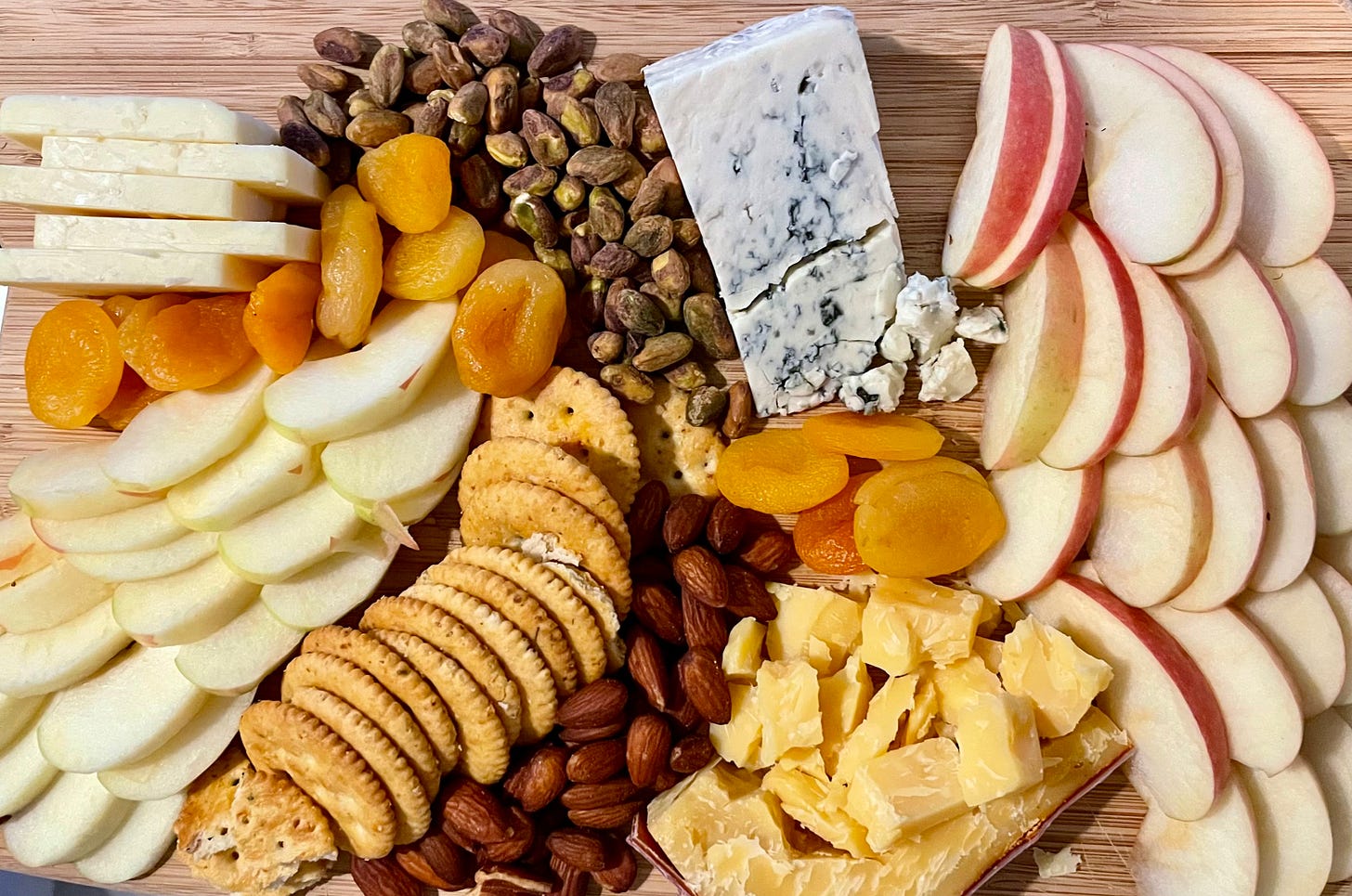
Pros: Packaging for shipping and quality upon arrival was all well thought out for maximum freshness. The selection of cheeses included a variety of textures and tasting notes. The amount of cheese (we had leftovers after our cheeseboard for dinner which we did not have with Murray’s), and the thorough research on each one.
Cons: All the cheeses were “safe” and did not challenge consumers or present an opportunity for them to learn more about the diversity found in cheese. The informational pamphlet was too lengthy and, while it did introduce the cheese producer to consumers, it ended up being more of a marketing message than educational.
January Winner:
MonthlyClubs.Com wins January because all their cheeses arrived in good quality; I tasted cheese from a producer I was not familiar with (Salemville Amish Blue from Salemville Cheese Cooperative); and, even though it was not in the cheese newsletter, I was able to use the Artikaas Vintage Lot 36 as an opportunity to educate my partner about tyrosine crystals in cheese.

